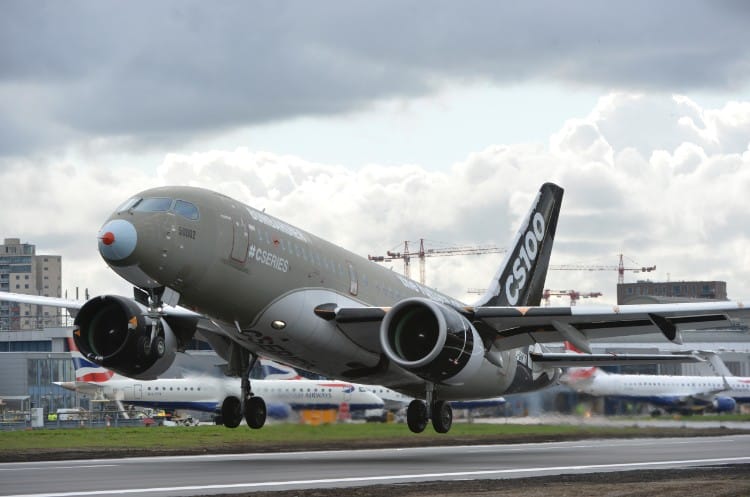Aerospace
Bombardier C Series Aircraft Completes Landmark Non-Stop Transatlantic Flight from London City Airport to New York John F. Kennedy Airport

- The CS100 would offer the only economically viable commercial option for direct intercontinental flights from London City to John F. Kennedy Airport
- Flight follows the completion of steep approach demonstration flights at London City Airport
- CS100 aircraft expected to receive Transport Canada and EASA steep approach certifications in the second quarter of 2017
Bombardier Commercial Aircraft confirmed today that a C Series aircraft with a representative payload successfully flew non-stop from London City Airport (LCY) to John F. Kennedy (JFK) Airport in New York City. The direct intercontinental flight followed a series of successful flights to demonstrate the CS100 aircraft’s exceptional capabilities for operations to and from LCY, including steep approach landing and short runway performance.
“The C Series aircraft program achieved another significant milestone with the completion of the demonstration tests at LCY. The C Series is the only commercial aircraft that was specifically designed for operations at LCY and we are very proud of its performance. The aircraft smoothly performed all eight take-offs and landings during a two-day period, as planned. This confirms the C Series aircraft’s unparalleled capabilities,” said Rob Dewar, Vice President, C Series Aircraft Program, Bombardier Commercial Aircraft. “The aircraft is meeting all performance expectations and clearly demonstrates that it is the best performing and most efficient aircraft in the 100- to 150-seat class.”
“It has been a pleasure to welcome the Bombardier CS100 aircraft and its team to London City Airport for the first time, as part of their testing and evaluation process. Following the landmark C Series non-stop flight to JFK, we look forward to the completion of its regulatory certification, followed by entry into commercial passenger operation with SWISS,” added Declan Collier, CEO of London City Airport.
Transport Canada and EASA certifications for steep approach operations with the CS100 aircraft is expected in the second quarter of 2017. Bombardier has extensive experience operating at LCY Airport with various aircraft types, including the Q400 turboprop aircraft, as well as the Challenger 650 aircraft and Global 5000 and Global 6000 business jets.
The CS100 aircraft is the most efficient and economical commercial aircraft allowing airlines to viably offer direct intercontinental flights from LCY Airport to both North America as well as the Middle-East on top of opening numerous new route opportunities within Europe, Russia and Northern Africa, which were not possible with old-generation aircraft.
SWISS is expected to be the first airline to offer service with the C Series to and from LCY later this year.
With the lowest noise and emissions levels of any commercial aircraft in its class, the C Series aircraft is ideal for urban operations and noise-sensitive airports. The CS100 aircraft has a much lower noise footprint compared to other commercial jets, and provides a better quality environment for London residents as it is the quietest commercial aircraft in production.

Aerospace
Boeing Transfers Rocket Stage to NASA, Paving Way for Human Moon Mission

Boeing has achieved a significant milestone by providing NASA with the second core stage of the Space Launch System (SLS) rocket.
This crucial component, crafted at NASA’s Michoud Assembly Facility (MAF), is set to propel the Artemis II crew into lunar orbit, marking humanity’s return to deep space after a 50-year hiatus.
The monumental Boeing-built rocket stage, the largest element of the Artemis II mission, will embark on a journey aboard the Pegasus barge, traveling 900 miles to NASA’s Kennedy Space Center.
Comparison of two legendary aircraft B777x vs B747 aircraft:Click here
Upon arrival, it will be meticulously integrated with other essential Artemis II components, including the upper stage, solid rocket boosters, and NASA’s Orion spacecraft within the iconic Vehicle Assembly Building. This intricate integration process is a vital step toward the eagerly anticipated Artemis II launch, slated for 2025.
“Boeing-built products helped land humankind on the moon in 1969, and we’re proud to continue that legacy through the Artemis generation,” remarked Dave Dutcher, vice president and program manager for Boeing’s SLS program. “Together, with NASA and our industry partners and suppliers, we are building the world’s most capable rocket and paving the way to deep space through America’s rocket factory in New Orleans.”
NASA, Lockheed Martin Reveal X-59 Quiet Supersonic Aircraft:Click here
The delivery of Core Stage 2 marks a significant achievement in the evolution of the SLS rocket. Towering over 200 feet and powered by four RS-25 engines, this core stage, coupled with two solid-fueled booster rockets, will generate a staggering 8.8 million pounds of thrust. This immense power is crucial to launching Artemis II and future missions into the vast expanse of space.
The SLS rocket stands unparalleled in its capability to transport both crew and substantial cargo to the moon and beyond in a single launch. Its extraordinary capacity will facilitate the delivery of human-rated spacecraft, habitats, and scientific missions to destinations including the moon and Mars, ushering in a new era of space exploration.
-

 Travel1 week ago
Travel1 week agoAir India to Expand US Operations with Three New Routes After a Decade
-

 Travel2 weeks ago
Travel2 weeks agoWhy We Should Avoid These Stamps in a Passport
-

 Airlines1 month ago
Airlines1 month agoInvestigations Reveal Fake Chinese Titanium in Boeing and Airbus Jets
-

 Tech4 weeks ago
Tech4 weeks agoChina’s CATL Plans 1,800-Mile Electric Plane Launch by 2027
-

 Airport3 days ago
Airport3 days agoTop 10 Largest Airports in the World by Size
-

 Aerospace4 weeks ago
Aerospace4 weeks agoChina’s Fighter Jets Turn Wings into Autonomous Drones
-

 Airlines4 days ago
Airlines4 days agoAir India Rolls Out A350s for Delhi-New York JFK and Newark Routes
-

 Defence3 weeks ago
Defence3 weeks agoBoeing Enhances Chinook with New Engines and Block II Upgrades at $96 Million







